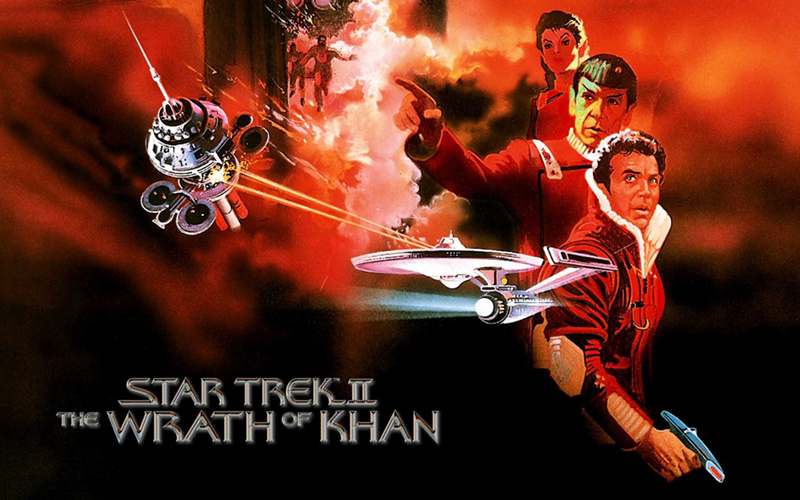Retro Review: Star Trek: Insurrection
7 min readWhen a Starfleet admiral allies the Federation with a race determined to destroy a peaceful paradise, Picard and the Enterprise crew rebel.
Plot Summary: Data appears to have major problems with his programming when, on a mission to observe a primitive culture, he removes the suit that keeps him invisible to them and exposes the disguised Starfleet base nearby. When Picard brings the Enterprise through the dangerous Briar Patch region of space to save Data, he finds that Starfleet Admiral Dougherty and a new Federation ally called the Son’a have been observing the isolated Ba’ku, who live in a small village with barely 600 people. Picard is surprised to find that the captured Starfleet officers and Son’a have been treated well, and even more surprised to learn from village leaders Anij and Sojef that the Ba’ku are familiar with warp drive and advanced technology; their race has simply decided to give up traveling the stars to focus on the cultivation of nature and inner development. The adult Ba’ku are hundreds of years old, sustained by the metaphasic radiation that suffuses the planet. Picard learns that the Son’a – who develop drugs for the Dominion and create weapons banned by the Khitomer Accords – have a plan to beam the Ba’ku onto a holographic ship and take them offworld so that Son’a leader Ru’afo can harvest the metaphasic radiation and sell what his people don’t need to rescue their own aged, degenerating species.
Dougherty insists to Picard that since there are only a few hundred Ba’ku and the entire Federation may benefit from age-reversing metaphasic radiation, no one will be willing to defend the Ba’ku. Picard insists that the forcible exile of an entire species, destroying their culture and way of life, goes against everything the Federation stands for, and his crew agrees to help him hide the Ba’ku in hills on the planet that shield them from transporter locks. The Son’a insist that the will not allow the rebels to delay their plan, which will render the planet uninhabitable and kill all living things on the surface as they harvest the radiation. When Dougherty tries belatedly to object – after giving tacit approval to a Son’a attempt to destroy the Enterprise in order to hide his own complicity in the illegal tactics used by the Son’a – Ru’afo kills him. But by now Picard has learned that the Son’a are, in fact, Ba’ku who fled the primitive lifestyle of their families, and some of the Son’a refuse to kill their parents and siblings. When Ru’afo tries to destroy the Ba’ku planet and collect the metaphasic radiation on his own, Picard fights him, stopping the attack before the Enterprise crew beams him to safety and helps restore the Ba’ku village to harmony.
Analysis:I’ve never felt that Insurrection has been given its due. I know it doesn’t have the scope of Generations and First Contact – no major character dies, Earth is never threatened, there are no Klingons or Borg attacking – the major threat is against Federation principles, and even there, we only see one evil admiral directly involved. But it feels much more like real Star Trek to me than either of the previous Next Generation films. Data’s seemingly out-of-character violence turns out to be, in retrospect, entirely in character, not the product of rage from an emotion chip but sincere fury over a profound act of betrayal that contradicts his programming. Picard’s anger arises not from psychological damage from a previous encounter with the Borg, but from the deeply held principles that made him one of Starfleet’s best captains, a man to be trusted with a starship despite his experiences as Locutus. As for the rest of the crew, they actually look, for a change, as though they are having fun, with each other and simply being alive. The Shangri-La effects restore LaForge’s eyesight and Worf’s teenage skin; they revive Picard’s libido and inspire Riker and Troi to fall in love with each other all over again. They even perk up Crusher’s boobs.
There’s quite a lot more humor in that vein along the way. Picard, Worf, and Data sing “A British Tar,” after Worf’s demurral that he has not met all the new crewmembers on the Enterprise yet, so he cannot be expected to recall Gilbert and Sullivan. After diving into a lake to rescue a woman who can’t swim, Data announces, “In the event of a water landing, I have been designed to serve as a flotation device.” Troi complains about kissing Riker with a beard, then shaves it off, naked in a bathtub. Upon discovering Anij’s true age, Picard claims he’s always been attracted to older women. The latter is a particularly nice touch in that this film was produced while UPN, in the throes of trying to attract a younger audience, was tinkering with Voyager and dumbing it down. Insurrection isn’t afraid to face up to subjects like aging: attempts by the Son’a to cling to youth, essentially stapling their skin into place when ordinary facelifts won’t work, are depicted as grotesque, and Dougherty fears that Starfleet is becoming aged and decrepit, given the incursions made by the Borg, the Cardassians, and lately the Dominion. The latter seems very far away, which is a waste, given what was happening on Deep Space Nine at the time this film is set; there could have been a subplot linking Starfleet’s desire to use metaphasic regeneration to help victims of the Dominion War.
It’s also a bit of a disappointment that Picard never really addresses the question of the price of protecting 600 Ba’ku from relocation, which means not only that LaForge won’t get his eyesight back and soldiers won’t recover from grievous wounds, but that whatever indigenous development was supposed to occur on the planet won’t take place anyway. I wish Picard had been as fervent about the rights of settlers during the Maquis conflict. Obviously it’s a terrible idea to kidnap a society off their planet to use the planet for personal gain, yet both Worf and Picard ended up agreeing that such a means of removing a culture from a dying world in “Homeward” wasn’t such a terrible idea in the end. I wonder whether Vulcan beliefs about the needs of the many outweighing the needs of the few might have convinced the Ba’ku to relocate willingly. The admiral has a point when he argues that by taking them away from their source of immortality, Starfleet would only be returning them to the natural order for their species. Of course, the admiral didn’t bother to find out where the Son’a came from, even though they’re newcomers to galactic politics and involved in all sorts of dealings with enemies of the Federation, so nothing he says is treated with much respect.
Since the Son’a have they manufactured Ketracel-White, a substance vital to the Dominion’s control of its soldiers, and broken the Khitomer Accords, creating subspace weapons (which Riker and LaForge do a nice job using against them), we’re not supposed to take their wishes seriously, either. Yet given the risks that have been taken in this franchise to bring various people back from the dead, I have to stop and wonder why not. I can think of many characters who might like to live to the Ba’ku planet, not only LaForge so he can see sunrises but Nog so he can regrow his amputated leg, Kes so she might live more than a brief Ocampa life span, Christopher Pike (if he’s still alive) so he can finally escape his wheelchair in reality instead of illusion. Wars are fought over secrets like the one the Ba’ku won’t fight to protect. The possibility of ongoing metaphysical and moral problems posed by this planet is intriguing. Of course, when the Son’a use an illegal deadly weapon, Riker and LaForge find a way to escape and not incidentally turn its effects back on its perpetrators. Meanwhile Picard knows that the Ba’ku are good guys because he learns some of their mental disciplines – stopping to smell the roses, literally, slowing time – and starts to fall in love with Anij, a slightly idealized woman of 350 or so who has somehow never learned to swim in all that time. If the romance feels a bit forced, the way Kirk HAD to date every female leader he met after a point, at least the woman is mostly a match for the captain.
The visuals in Insurrection are superb, from the computer effects to the glorious shots of the Sierra Nevada range (which serve as the mountains of the Ba’ku planet). After the literal and metaphysical darkness of First Contact, I find this one much more pleasant to watch; the cast looks good, too, particularly Sirtis and Frakes who seem delighted to be flirting, and Spiner chewing scenery both as angry defensive Data and childlike studious Data. And Patrick Stewart really comes into his own in this film. He isn’t dwarfed by machinery, history, and the Borg Queen as he was in First Contact, and he isn’t dwarfed by Kirk as he was in Generations. He’s very much the captain, particularly in the final one-on-one confrontation with Ru’afo. I’m just sorry we don’t get to see the subsequent confrontation with Starfleet. But at least his crew didn’t blow up the ship!






